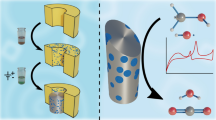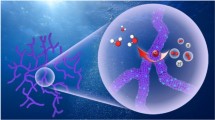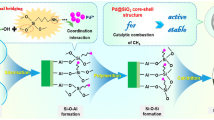Abstract
The issues of hydrogen generation and storage have hindered the widespread use and commercialization of hydrogen fuel cell vehicles. It is thus highly attractive, but the design and development of highly active non-noble-metal catalysts for on-demand hydrogen release from alkaline NaBH4 solution under mild conditions remains a key challenge. Herein, we describe the use of CoP nanowire array integrated on a Ti mesh (CoP NA/Ti) as a three-dimensional (3D) monolithic catalyst for efficient hydrolytic dehydrogenation of NaBH4 in basic solutions. The CoP NA/Ti works as an on/off switch for on-demand hydrogen generation at a rate of 6,500 mL/(min·g) and a low activation energy of 41 kJ/mol. It is highly robust for repeated usage after recycling, without sacrificing catalytic performance. Remarkably, this catalyst also performs efficiently for the hydrolysis of NH3BH3.

Similar content being viewed by others
References
Schlapbach, L.; Züttel, A. Hydrogen-storage materials for mobile applications. Nature 2001, 414, 353–358.
Yadav, M.; Xu, Q. Liquid-phase chemical hydrogen storage materials. Energy Environ. Sci. 2012, 5, 9698–9725.
Zhou, L. M.; Zhang, T. R.; Tao, Z. L.; Chen, J. Ni nanoparticles supported on carbon as efficient catalysts for the hydrolysis of ammonia borane. Nano Res. 2014, 7, 774–781.
Peng, B.; Chen, J. Functional materials with high-efficiency energy storage and conversion for batteries and fuel cells. Coord. Chem. Rev. 2009, 253, 2805–2813.
Jacobson, M. Z.; Colella, W. G.; Golden, D. M. Cleaning the air and improving health with hydrogen fuel-cell vehicles. Science 2005, 308, 1901–1905.
Peng, B.; Chen, J. Ammonia borane as an efficient and lightweight hydrogen storage medium. Energy Environ. Sci. 2008, 1, 479–483.
Xia, B. Q.; Chen, K.; Luo, W.; Cheng, G. Z. NiRh nanoparticles supported on nitrogen-doped porous carbon as highly efficient catalysts for dehydrogenation of hydrazine in alkaline solution. Nano Res. 2015, 8, 3472–3479.
Cheng, F.; Tao, Z.; Liang, J.; Chen, J. Efficient hydrogen storage with the combination of lightweight Mg/MgH2 and nanostructures. Chem. Commun. 2012, 48, 7334–7343.
Liu, C.; Fan, Y. Y.; Liu, M.; Cong, H. T.; Cheng, H. M.; Dresselhaus, M. S. Hydrogen storage in single-walled carbon nanotubes at room temperature. Science 1999, 286, 1127–1129.
Bechelany, M.; Abou Chaaya, A.; Frances, F.; Akdim, O.; Cot, D.; Demirci, U. B.; Miele, P. Nanowires with controlled porosity for hydrogen production. J. Mater. Chem. A 2013, 1, 2133–2138.
Eberle, U.; Felderhoff, M.; Schüth, F. Chemical and physical solutions for hydrogen storage. Angew. Chem., Int. Ed. 2009, 48, 6608–6630.
Wang, S. H.; Fan, Y.; Chen, M. Q.; Xie, Y. Y.; Wang, D. W.; Su, C.-Y. Porous Co-P-Pd nanotube arrays for hydrogen generation by catalyzing the hydrolysis of alkaline NaBH4 solution. J. Mater. Chem. A 2015, 3, 8250–8255.
Bhattacharjee, D.; Dasgupta, S. Trimetallic NiFePd nanoalloy catalysed hydrogen generation from alkaline hydrous hydrazine and sodium borohydride at room temperature. J. Mater. Chem. A 2015, 3, 24371–24378.
Brown, H. C.; Brown, C. A. New, highly active metal catalysts for the hydrolysis of borohydride. J. Am. Chem. Soc. 1962, 84, 1493–1494.
Schlesinger, H. I.; Brown, H. C.; Finholt, A. E.; Gilbreath, J. R.; Hoekstra, H. R.; Hyde, E. K. Sodium borohydride, its hydrolysis and its use as a reducing agent and in the generation of hydrogen. J. Am. Chem. Soc. 1953, 75, 215–219.
Liu, B. H.; Li, Z. P. A review: Hydrogen generation from borohydride hydrolysis reaction. J. Power Sources 2009, 187, 527–534.
Liao, J. Y.; Li, H.; Zhang, X. B.; Feng, K. J.; Yao, Y. L. Fabrication of a Ti-supported NiCo2O4 nanosheet array and its superior catalytic performance in the hydrolysis of ammonia borane for hydrogen generation. Catal. Sci. Technol. 2016, 6, 3893–3899.
Paladini, M.; Arzac, G. M.; Godinho, V.; Jiménez de Haro, M. C.; Fernández, A. Supported Co catalysts prepared as thin films by magnetron sputtering for sodium borohydride and ammonia borane hydrolysis. Appl. Catal. B: Environ. 2014, 158–159, 400–409.
Tian, J. Q.; Liu, Q.; Cheng, N. Y.; Asiri, A. M.; Sun, X. P. Self-supported Cu3P nanowire arrays as an integrated high-performance three-dimensional cathode for generating hydrogen from water. Angew. Chem., Int. Ed. 2014, 53, 9577–9581.
Ren, Z.; Guo, Y. B.; Gao, P.-X. Nano-array based monolithic catalysts: Concept, rational materials design and tunable catalytic performance. Catal. Today 2015, 258, 441–453.
Kuang, Y.; Feng, G.; Li, P. S.; Bi, Y. M.; Li, Y. P.; Sun, X. M. Single-crystalline ultrathin nickel nanosheets array from in situ topotactic reduction for active and stable electrocatalysis. Angew. Chem., Int. Ed. 2016, 55, 693–697.
Popczun, E. J.; Read, C. G.; Roske, C. W.; Lewis, N. S.; Schaak, R. E. Highly active electrocatalysis of the hydrogen evolution reaction by cobalt phosphide nanoparticles. Angew. Chem., Int. Ed. 2014, 53, 5427–5430.
Tian, J. Q.; Cheng, N. Y.; Liu, Q.; Xing, W.; Sun, X. P. Cobalt phosphide nanowires: Efficient nanostructures for fluorescence sensing of biomolecules and photocatalytic evolution of dihydrogen from water under visible light. Angew. Chem., Int. Ed. 2015, 54, 5493–5497.
Liu, Q.; Tian, J. Q.; Cui, W.; Jiang, P.; Cheng, N. Y.; Asiri, A. M.; Sun, X. P. Carbon nanotubes decorated with CoP nanocrystals: A highly active non-noble-metal nanohybrid electrocatalyst for hydrogen evolution. Angew. Chem., Int. Ed. 2014, 53, 6710–6714.
Grosvenor, A. P.; Wik, S. D.; Cavell, R. G.; Mar, A. Examination of the bonding in binary transition-metal monophosphides MP(M = Cr, Mn, Fe, Co) by X-ray photoelectron spectroscopy. Inorg. Chem. 2005, 44, 8988–8998.
Li, H.; Yang, P. F.; Chu, D. S.; Li, H. X. Selective maltose hydrogenation to maltitol on a ternary Co–P–B amorphous catalyst and the synergistic effects of alloying B and P. Appl. Catal. A: Gen. 2007, 325, 34–40.
Liu, C.-H.; Chen, B.-H.; Hsueh, C.-L.; Ku, J.-R.; Tsau, F.; Hwang, K.-J. Preparation of magnetic cobalt-based catalyst for hydrogen generation from alkaline NaBH4 solution. Appl. Catal. B: Environ. 2009, 91, 368–379.
Ai, L. H.; Gao, X. Y.; Jiang, J. In situ synthesis of cobalt stabilized on macroscopic biopolymer hydrogel as economical and recyclable catalyst for hydrogen generation from sodium borohydride hydrolysis. J. Power Sources 2014, 257, 213–220.
Li, H.; Liao, J. Y.; Zhang, X. B.; Liao, W. W.; Wen, L. L.; Yang, J. B.; Wang, H.; Wang, R. F. Controlled synthesis of nanostructured Co film catalysts with high performance for hydrogen generation from sodium borohydride solution. J. Power Sources 2013, 239, 277–283.
Xu, D. Y.; Wang, H. Z.; Guo, Q. J.; Ji, S. F. Catalytic behavior of carbon supported Ni–B, Co–B and Co–Ni–B in hydrogen generation by hydrolysis of KBH4. Fuel Process. Technol. 2011, 92, 1606–1610.
Guella, G.; Patton, B.; Miotello, A. Kinetic features of the platinum catalyzed hydrolysis of sodium borohydride from 11B NMR measurements. J. Phys. Chem. C 2007, 111, 18744–18750.
Wu, Z. J.; Mao, X. K.; Zi, Q.; Zhang, R. R.; Dou, T.; Yip, A. C. K. Mechanism and kinetics of sodium borohydride hydrolysis over crystalline nickel and nickel boride and amorphous nickel–boron nanoparticles. J. Power Sources 2014, 268, 596–603.
Guella, G.; Zanchetta, C.; Patton, B.; Miotello, A. New insights on the mechanism of palladium-catalyzed hydrolysis of sodium borohydride from 11B NMR measurements. J. Phys. Chem. B 2006, 110, 17024–17033.
Peña-Alonso, R.; Sicurelli, A.; Callone, E.; Carturan, G.; Raj, R. A picoscale catalyst for hydrogen generation from NaBH4 for fuel cells. J. Power Sources 2007, 165, 315–323.
Holbrook, K. A.; Twist, P. J. Hydrolysis of the borohydride ion catalysed by metal–boron alloys. J. Chem. Soc. A 1971, 890–894.
Patel, N.; Miotello, A. Progress in Co–B related catalyst for hydrogen production by hydrolysis of boron-hydrides: A review and the perspectives to substitute noble metals. Int. J. Hydrog. Energy 2015, 40, 1429–1464.
Walter, J. C.; Zurawski, A.; Montgomery, D.; Thornburg, M.; Revankar, S. Sodium borohydride hydrolysis kinetics comparison for nickel, cobalt, and ruthenium boride catalysts. J. Power Sources 2008, 179, 335–339.
Popczun, E. J.; McKone, J. R.; Read, C. G.; Biacchi, A. J.; Wiltrout, A. M.; Lewis, N. S.; Schaak, R. E. Nanostructured nickel phosphide as an electrocatalyst for the hydrogen evolution reaction. J. Am. Chem. Soc. 2013, 135, 9267–9270.
Akdim, O.; Demirci, U. B.; Muller, D.; Miele, P. Cobalt (II) salts, performing materials for generating hydrogen from sodium borohydride. Int. J. Hydrog. Energy 2009, 34, 2631–2637.
Erogbogbo, F.; Lin, T.; Tucciarone, P. M.; LaJoie, K. M.; Lai, L.; Patki, G. D.; Prasad, P. N.; Swihart, M. T. Ondemand hydrogen generation using nanosilicon: Splitting water without light, heat, or electricity. Nano Lett. 2013, 13, 451–456.
Sattler, W.; Parkin, G. Zinc catalysts for on-demand hydrogen generation and carbon dioxide functionalization. J. Am. Chem. Soc. 2012, 134, 17462–17465.
Zhu, Q.-L.; Xu, Q. Liquid organic and inorganic chemical hydrides for high-capacity hydrogen storage. Energy Environ. Sci. 2015, 8, 478–512.
Metin, Ö.; Özkar, S.; Sun, S. H. Monodisperse nickel nanoparticles supported on SiO2 as an effective catalyst for the hydrolysis of ammonia-borane. Nano Res. 2010, 3, 676–684.
Aranishi, K.; Jiang, H.-L.; Akita, T.; Haruta, M.; Xu, Q. One-step synthesis of magnetically recyclable Au/Co/Fe triple-layered core–shell nanoparticles as highly efficient catalysts for the hydrolytic dehydrogenation of ammonia borane. Nano Res. 2011, 4, 1233–1241.
Sanyal, U.; Demirci, U. B.; Jagirdar, B. R.; Miele, P. Hydrolysis of ammonia borane as a hydrogen source: Fundamental issues and potential solutions towards implementation. ChemSusChem 2011, 4, 1731–1739.
Marder, T. B. Will we soon be fueling our automobiles with ammonia–borane? Angew. Chem., Int. Ed. 2007, 46, 8116–8118.
Yao, Q. L.; Lu, Z.-H.; Huang, W.; Chen, X. S.; Zhu, J. High Pt-like activity of the Ni–Mo/graphene catalyst for hydrogen evolution from hydrolysis of ammonia borane. J. Mater. Chem. A 2016, 4, 8579–8583.
Glüer, A.; Förster, M.; Celinski, V. R.; Schmedt auf der Gü nne, J.; Holthausen, M. C.; Schneider, S. Highly active iron catalyst for ammonia borane dehydrocoupling at room temperature. ACS Catal. 2015, 5, 7214–7217.
Peng, C. Y.; Kang, L.; Cao, S.; Chen, Y.; Lin, Z. S.; Fu, W. F. Nanostructured Ni2P as a robust catalyst for the hydrolytic dehydrogenation of ammonia–borane. Angew. Chem., Int. Ed. 2015, 54, 15725–15729.
Chen, G. Z.; Desinan, S.; Rosei, R.; Rosei, F.; Ma, D. L. Synthesis of Ni–Ru alloy nanoparticles and their high catalytic activity in dehydrogenation of ammonia borane. Chem.—Eur. J. 2012, 18, 7925–7930.
Wang, H. X.; Zhao, Y. R.; Cheng, F. Y.; Tao, Z. L.; Chen, J. Cobalt nanoparticles embedded in porous N-doped carbon as long-life catalysts for hydrolysis of ammonia borane. Catal. Sci. Technol. 2016, 6, 3443–3448.
Mohajeri, N.; T-Raissi, A.; Adebiyi, O. Hydrolytic cleavage of ammonia-borane complex for hydrogen production. J. Power Sources 2007, 167, 482–485.
Metin, Ö.; Sahin, S.; Özkar, S. Water-soluble poly(4-styrenesulfonic acid-co-maleic acid) stabilized ruthenium(0) and palladium(0) nanoclusters as highly active catalysts in hydrogen generation from the hydrolysis of ammonia–borane. Int. J. Hydrog. Energy 2009, 34, 6304–6313
Acknowledgements
This work was supported by Qingdao Innovation Leading Expert Program, Qingdao Basic & Applied Research project (No. 15-9-1-100-jch).
Author information
Authors and Affiliations
Corresponding author
Electronic supplementary material
12274_2016_1318_MOESM1_ESM.pdf
Monolithically integrated CoP nanowire array: An on/off switch for effective on-demand hydrogen generation via hydrolysis of NaBH4 and NH3BH3
Rights and permissions
About this article
Cite this article
Cui, L., Xu, Y., Niu, L. et al. Monolithically integrated CoP nanowire array: An on/off switch for effective on-demand hydrogen generation via hydrolysis of NaBH4 and NH3BH3 . Nano Res. 10, 595–604 (2017). https://doi.org/10.1007/s12274-016-1318-0
Received:
Revised:
Accepted:
Published:
Issue Date:
DOI: https://doi.org/10.1007/s12274-016-1318-0




